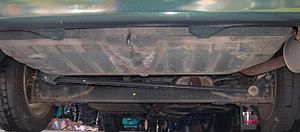Beam axle
This article needs additional citations for verification. (October 2021) |

A beam axle, rigid axle or solid axle is a
dependent suspension design in which a set of wheels is connected laterally by a single beam or shaft. Beam axles were once commonly used at the rear wheels of a vehicle, but historically they have also been used as front axles in four-wheel-drive vehicles. In most automobiles, beam axles have been replaced with front (IFS) and rear independent suspensions
(IRS).
Implementation
suspension
characteristics: Camber change on bumps, none on rebound, large unsprung weightWith a beam axle, the camber angle between the wheels is the same no matter where it is in the travel of the suspension.
A beam axle's fore & aft location is constrained by either:
Shock absorbers and either leaf springs, coil springs, or air bags
are used to control vertical movement.
The
anti-roll bar
to control the roll motion of the body, and is considered to be a semi-independent suspension design.
Live axle vs dead axle

A live axle is a type of beam axle in which the shaft (or, commonly, shafts connected to move as a single unit) also transmits power to the wheels; a beam axle that does not also transmit power is sometimes called a dead axle. While typically used in vehicles with Hotchkiss drive, this suspension system can also be used with other types of power transmission.
Advantages
- A beam axle is typically simple in design, rugged, and inexpensive to manufacture.
- Only one universal joint or constant-velocity joint (CV) is needed at each steered and driven wheel and none are needed at non-steered wheels; this reduces maintenance requirements and manufacturing costs compared to independent suspensions, which typically require two such joints at each driven wheel.
- The CVs are located in metal enclosures attached to the axle housings, there are no rubber CV boots that maybe cut or punctured when off-roading.
- A beam axle is space-efficient, an important advantage for off-road applications, as it provides better vehicle articulation and durability in a high load environment.
- Camber angle is rigidly fixed by axle geometry; for a live axle, toe is typically fixed as well.
- As the vehicle's body rolls during hard cornering, the unchanging camber yields predictable handling—at least on smooth surfaces.
- Wheel alignment is simplified.
- Traction, braking and tire wear characteristics do not change as the suspension is compressed. These are great benefits in a vehicle that carries heavy loads, and together with the beam axle's characteristic strength, this has resulted in front and rear beam axles being nearly universal in also use a beam axle, at least in the rear.
- Easier, cheaper to modify, due to less parts, mechanical complexity and typically more empty space (to work with) between suspension components, axles and the vehicle's frame/body.[1]
- lift kitsto increase body and/or running clearance
- larger diameter tyres to increase ground/axle clearance
Disadvantages
- A beam axle does not allow each wheel to move independently in response to uneven surfaces, and handling is typically worse than more sophisticated suspension designs.
- In turns, the outside wheel is often subjected to adverse camber angles when the inside wheel hits a bump, which can suddenly reduce cornering grip and destabilize the vehicle.
- If one wheel on an axle slides off a steep incline or is knocked to one side by a rock (when driving at high speeds), the other wheel will also follow due to the physical connection of the two wheels on an axle. If this happens on the front axle the whole vehicle may suddenly jump towards that side.[2] If there is lack of (enough) steering dampening, the driver maybe suffer dislocated fingers or shoulder due to the sudden steering wheel feedback.[3]
- Camber angle cannot change during body roll. Furthermore, the roll center moves in reaction to road irregularities
- Toe is typically fixed at zero for a live axle, and dynamic toe control is difficult to implement.
- The mass of the beam is part of the unsprung weight of the vehicle, hurting ride quality.
- The need for lateral location devices such as a Panhard rod or Watt's linkage adds more unsprung weight and partially offsets the beam axle's advantages in simplicity, space efficiency and cost.
- In a vehicle with conventional Hotchkiss drive, the entire axle may twist in its mounts in reaction to torque loads; during hard acceleration, this may reduce traction and induce wheel hop or sudden adverse toe changes.
- The bulky differential housing of a Hotchkiss live axle reduces ground clearance, hindering the vehicle's ability to ford deep mud, clear obstacles and negotiate deeply rutted roads.
- Front beam axle suspension is unusually sensitive to any lack of concentricity in the hub and wheel assembly which can cause a side-to-side oscillation ("shimmy") of the steering at certain speeds (typically 60–80 kilometres per hour (40–50 mph)), commonly referred to as "death wobble" within the 4x4 community.[4] This is addressed on some vehicles with steering dampers, although removal and careful refitting of the front wheels often cures the problem.
Examples
Modern production vehicles with solid front axle
- Suzuki Jimny
- Jeep Wrangler
- Jeep Gladiator
- Toyota Land Cruiser 70 Series
- Mercedes-Benz G-Class (1990-2019)
- Land Rover Defender (1990-2016)
- Beijing BJ212
- Ford Super Duty
- Ram Heavy Duty (fifth generation)
- Mahindra Bolero Pik-Up
Unibody modern production vehicles with solid axle
- Jeep Liberty
- Jeep Grand Cherokee (2004-2010)
- Jeep Cherokee (XJ)
- Jeep Commander (2005-2010)
- Dodge Nitro
- Lada Niva
See also
Notes
- ^ THE COST OF CHOOSING BIGGER 4x4 TYRES. Retrieved 2024-04-12 – via www.youtube.com.
- ^ 2022 Season Video: A Highlight of the Jeepspeed Race Series. Retrieved 2024-04-12 – via www.youtube.com.
- ^ "10 Off Road tips for inside the cab". 4 Wheeling Australia. Retrieved 2024-04-12.
- ^ Lingeman, Jake. "Autoweek explains: What is the 'death wobble'?". Autoweek. Retrieved 2 October 2021.
